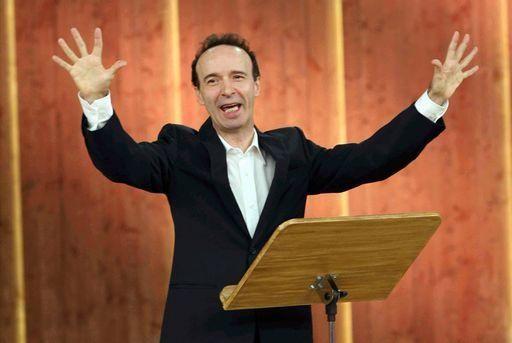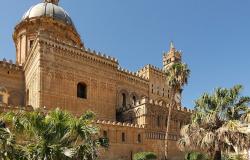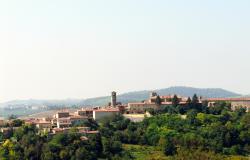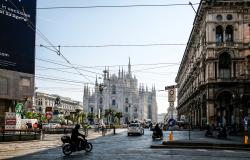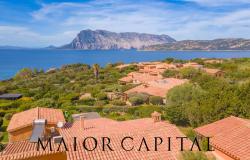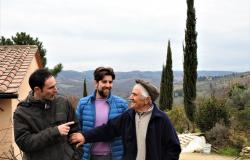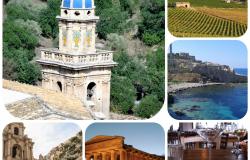Yesterday, 12.619.000 Italians tuned in to Rai 1 during prime time to hear Roberto Benigni's reading of the Italian Constitution. With this show/lecture entitled 'La più bella del Mondo” [The most beautiful in the world], he tried to make Italians fall in love with their country's constitution.
He kicked off the show briefly mentioning Silvio Berlusconi's political comeback. "Silvio is back. God have mercy on us!" he joked. . .Then he began talking about 'The Most beautiful in the World': The Constitution of the Italian Republic.
The Constituent Assembly, which produced this document, was elected by universal suffrage on the 2nd of June 1946, at the same time as a referendum on the abolition of the monarchy, and the document was enacted on the 22nd of December 1947, coming into force on the 1st of January 1948.
The forces that enlivened debate in the Assembly fell into three main groups, Christian democratic, Liberal and left-wing. Because the members of the assembly had been involved in the struggle to free Italy from the fascist dictatorship and witnessed the tragedies brought by WWII, they shared a general agreement against an authoritarian constitution, thus writing a text which places human rights at its core. As Benigni remarked, at the time, this was a revolutionary approach, if you just think that the The Universal Declaration of Human Rights was adopted by the United Nations General Assembly a year later, on the 10th of December 1948.
One of the members of the constituent assembly, Prof. Piero Calamandrei, explained:
If you want to go on a pilgrimage to the place where our Constitution was created go to the mountains where partisans fell, to the prisons where they were incarcerated and to the fields where they were hanged. Wherever an Italian died to redeem freedom and dignity, go there young people and ponder: because that was where our Constitution was born.
Benigni's show focused on the 12 Fundamental Principles. ‘The Italian Constitution is an extraordinary document,' stated the director of the Oscar-winning film Life is Beautiful, ‘as important today as Brunelleschi's Dome.[...]The authors of the Constitution illuminated the road to happiness with the 12 principles, which so many other nation states have copied since'.
You can find the Fundamental Principles of the Italian Constitution below, you can download the full English version of the document here.
CONSTITUTION OF THE ITALIAN REPUBLIC FUNDAMENTAL PRINCIPLES
Art. 1
Italy is a democratic Republic founded on labour. Sovereignty belongs to the people and is exercised by the people in the forms and within the limits of the Constitution.
Art. 2
The Republic recognises and guarantees the inviolable rights of the person, both as an individual and in the social groups where human personality is expressed. The Republic expects that the fundamental duties of political, economic and social solidarity be fulfilled.
Art. 3
All citizens have equal social dignity and are equal before the law, without distinction of sex, race, language, religion, political opinion, personal and social conditions. It is the duty of the Republic to remove those obstacles of an economic or social nature which constrain the freedom and equality of citizens, thereby impeding the full development of the human person and the effective participation of all workers in the political, economic and social organisation of the country.
Art. 4
The Republic recognises the right of all citizens to work and promotes those conditions which render this right effective. Every citizen has the duty, according to personal potential and individual choice, to perform an activity or a function that contributes to the material or spiritual progress of society.
Art. 5
The Republic is one and indivisible. It recognises and promotes local autonomies, and implements the fullest measure of administrative decentralisation in those services which depend on the State. The Republic adapts the principles and methods of its legislation to the requirements of autonomy and decentralisation.
Art. 6
The Republic safeguards linguistic minorities by means of appropriate measures.
Art. 7
The State and the Catholic Church are independent and sovereign, each within its own sphere. Their relations are regulated by the Lateran pacts. Amendments to such Pacts which are accepted by both parties shall not require the procedure of constitutional amendments.
Art. 8
All religious denominations are equally free before the law. Denominations other than Catholicism have the right to self-organisation according to their own statutes, provided these do not conflict with Italian law. Their relations with the State are regulated by law, based on agreements with their respective representatives.
Art. 9
The Republic promotes the development of culture and of scientific and technical research. It safeguards natural landscape and the historical and artistic heritage of the Nation.
Art. 10
The Italian legal system conforms to the generally recognised principles of international law. The legal status of foreigners is regulated by law in conformity with international provisions and treaties. A foreigner who, in his home country, is denied the actual exercise of the democratic freedoms guaranteed by the Italian constitution shall be entitled to the right of asylum under the conditions established by law. A foreigner may not be extradited for a political offence.
Art. 11
Italy rejects war as an instrument of aggression against the freedom of other peoples and as a means for the settlement of international disputes. Italy agrees, on conditions of equality with other States, to the limitations of sovereignty that may be necessary to a world order ensuring peace and justice among the Nations. Italy promotes and encourages international organisations furthering such ends.
Art. 12
The flag of the Republic is the Italian tricolour: green, white and red, in three vertical bands of equal size.
